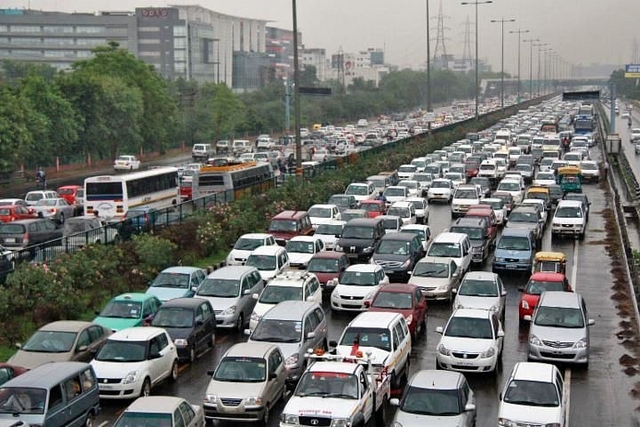
How Car And Two-Wheeler Levies Can Be Cut: We Must Tax Usage, Not Mere Ownership
Auto taxes are high, but they cannot be rationalised as long as the idea is to tax ownership rather than usage.
Taxation cannot be determined by revenue considerations alone.
The central government’s response to automakers’ demands for tax cuts to help them boost sales is neither here nor there. Newspapers today (18 September) carried reports, attributed to a Finance Ministry official, that goods and services tax (GST) rates are not as high as they were before GST.
Auto companies also received gratuitous advice on cutting costs, including royalty payments to their parent companies abroad, to ride out the recession.
The problem is not high taxes or royalties; rather it is about the lack of clarity on how automobiles should be taxed in India. If tax policies are not based on the outcomes policy-makers desire, taxes will be imposed or reduced opportunistically based on which lobby is able to get its views endorsed by politicians and Finance Ministry mandarins.
What should guide automobile taxation policies are the following important public outcomes: lower pollution, reduction of congestion in cities, reduction of automobile usage in general so that public transport gets a bigger share of public infrastructure as soon as possible.
Public transport does not only mean suburban trains and metros, but also buses (of various sizes) and ride-hailing services involving taxis and autos, and other types of multi-user vehicles that are for public hire.
Let’s take pollution. If you want to reduce automobile pollution, you need to tax polluting vehicles more than less polluting vehicles, leaving the lowest tax slab available for electric vehicles, and slightly higher taxes for hybrid vehicles (thus Toyota should be happier and feel loved by India).
Deciding taxation based on engine capacity or the length of the vehicle makes little sense since a bigger vehicle may well be more modern and cause less pollution. This implies that taxes should be based on two principles: estimated polluting potential of a vehicle during its lifetime, with annual road taxes that rise with the age of the vehicle.
Instead of collecting road taxes upfront, they should be lowered for initial purchase and paid annually, with slabs rising every three years. They should be very high (and thus fit for scrapping) once they reach 10 years of usage. Incentives to scrap vehicles over 10 years will benefit the auto industry.
Next, take congestion. The only logical and sensible way to reduce congestion is by metering car movements in congested areas in cities. This means all cities which do not have adequate road spaces for their car and two-wheeler populations should create the necessary infrastructure (with RFID chips stuck on all vehicles) to make users pay for using congested streets or areas, especially central business districts.
Thus, cities will get resources from tolls deducted through the use of devices like FASTags. Paying for the use of congested areas should become the new normal, just as we pay more for higher electricity usage and tolls on highways.
Third, metros and extensions of current suburban train networks are vital investments to make in urban infrastructure, but there is no reason why buses, minibuses, vans and even SUVs cannot be used as public transport, apart from ride-hailing cabs, autos and bikes.
If we want to make people share private vehicles, one has to incentivise the conversion of private cars into semi-commercial vehicles for nominal charges – the only increase being in insurance charges. One also must cut taxes on public vehicles to the lowest levels, on a par with electric vehicles. SUVs that are used as public transport vehicles should be taxed less than those for personal use.
If we accept these ideas, they imply the following directional moves:
#1: We should cut taxes on cars and bikes after the Covid-19 crisis, for the intention is not to penalise mere ownership. What should be raised is taxes on usage, from congestion surcharges to tolls to parking fees and special pollution surcharges leviable and payable once a vehicle crosses the three-year ownership mark (or a prescribed mileage level). High GST rates can be normalised once user charges are raised steadily.
#2: The taxes, fees and charges levied on public transport vehicles – buses, taxis, autos, and private cars converted to partial public usage – should be cut drastically. These vehicles should instead be charged on usage, which will cover for any revenue losses. Lower taxes will also encourage private operators of public vehicles to expand services. This tax cut should happen even during Covid-19, for the infection needs the public to travel in buses that are not crowded.
#3: Yes, high taxes on fuel are important. This is one policy both the Centre and states got right, even though for the wrong reasons.
#4: This kind of rational automobile taxation policy has to be coordinated by the Centre, states and municipal bodies, even though parts of the policies can be implemented by anyone.
The point to underline is this: auto taxes are high, but they cannot be rationalised as long as the idea is to tax ownership rather than usage. And yes, taxation cannot be determined by revenue considerations alone.